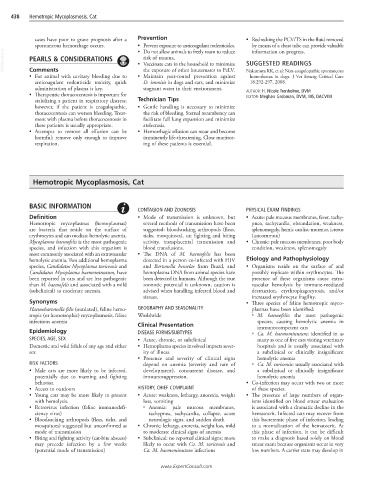Page 901 - Cote clinical veterinary advisor dogs and cats 4th
P. 901
438 Hemotropic Mycoplasmosis, Cat
cases have poor to grave prognosis after a Prevention • Rechecking the PCV/TS in the fluid removed
spontaneous hemorrhage occurs. • Prevent exposure to anticoagulant rodenticides. by means of a chest tube can provide valuable
VetBooks.ir PEARLS & CONSIDERATIONS • Vaccinate cats in the household to minimize SUGGESTED READINGS
• Do not allow animals to freely roam to reduce
information on progress.
risk of trauma.
Comments
the exposure of other housemates to FeLV.
• For animal with cavitary bleeding due to • Maintain year-round prevention against Nakamura RK, et al: Non-coagulopathic spontaneous
hemothorax in dogs. J Vet Emerg Critical Care
anticoagulant rodenticide toxicity, quick D. immitis in dogs and cats, and minimize 18:292-297, 2008.
administration of plasma is key. stagnant water in their environment.
• Therapeutic thoracocentesis is important for AUTHOR: H. Nicole Trenholme, DVM
EDITOR: Meghan Grobman, DVM, MS, DACVIM
stabilizing a patient in respiratory distress; Technician Tips
however, if the patient is coagulopathic, • Gentle handling is necessary to minimize
thoracocentesis can worsen bleeding. Treat- the risk of bleeding. Sternal recumbency can
ment with plasma before thoracocentesis in facilitate full lung expansion and minimize
these patients is usually appropriate. atelectasis.
• Attempts to remove all effusion can be • Hemorrhagic effusion can recur and become
harmful; remove only enough to improve imminently life-threatening. Close monitor-
respiration. ing of these patients is essential.
Hemotropic Mycoplasmosis, Cat
BASIC INFORMATION
CONTAGION AND ZOONOSIS PHYSICAL EXAM FINDINGS
Definition • Mode of transmission is unknown, but • Acute: pale mucous membranes, fever, tachy-
Hemotropic mycoplasmas (hemoplasmas) several methods of transmission have been pnea, tachycardia, obtundation, weakness,
are bacteria that reside on the surface of suggested: bloodsucking arthropods (fleas, splenomegaly, hemic cardiac murmur, icterus
erythrocytes and can mediate hemolytic anemia. ticks, mosquitoes), cat fighting and biting (uncommon)
Mycoplasma haemofelis is the most pathogenic activity, transplacental transmission and • Chronic: pale mucous membranes, poor body
species, and infection with this organism is blood transfusions. condition, weakness, splenomegaly
most commonly associated with an extravascular • The DNA of M. haemofelis has been
hemolytic anemia. Two additional hemoplasma detected in a person co-infected with HIV Etiology and Pathophysiology
species, Candidatus Mycoplasma turicensis and and Bartonella henselae from Brazil, and • Organisms reside on the surface of and
Candidatus Mycoplasma haemominutum, have hemoplasma DNA from animal species have possibly replicate within erythrocytes. The
been reported in cats and are less pathogenic been detected in humans. Although the true presence of these organisms cause extra-
than M. haemofelis and associated with a mild zoonotic potential is unknown, caution is vascular hemolysis by immune-mediated
(subclinical) to moderate anemia. advised when handling infected blood and destruction, erythrophagocytosis, and/or
tissues. increased erythrocyte fragility.
Synonyms • Three species of feline hemotropic myco-
Haemobartonella felis (outdated), feline hemo- GEOGRAPHY AND SEASONALITY plasmas have been identified:
tropic (or hemotrophic) mycoplasmosis, feline Worldwide ○ M. haemofelis: the most pathogenic
infectious anemia species, causing hemolytic anemia in
Clinical Presentation
immunocompetent cats
Epidemiology DISEASE FORMS/SUBTYPES ○ Ca. M. haemominutum: identified in as
SPECIES, AGE, SEX • Acute, chronic, or subclinical many as one of five cats visiting veterinary
Domestic and wild felids of any age and either • Hemoplasma species involved impacts sever- hospitals and is usually associated with
sex ity of illness. a subclinical or clinically insignificant
• Presence and severity of clinical signs hemolytic anemia
RISK FACTORS depend on anemia (severity and rate of ○ Ca. M. turicensis: usually associated with
• Male cats are more likely to be infected, development), concurrent disease, and a subclinical or clinically insignificant
potentially due to roaming and fighting immunosuppression. hemolytic anemia
behavior. • Co-infection may occur with two or more
• Access to outdoors HISTORY, CHIEF COMPLAINT of these species.
• Young cats may be more likely to present • Acute: weakness, lethargy, anorexia, weight • The presence of large numbers of organ-
with hemolysis. loss, vomiting isms identified on blood smear evaluation
• Retrovirus infection (feline immunodefi- ○ Anemia: pale mucous membranes, is associated with a dramatic decline in the
ciency virus) tachypnea, tachycardia, collapse, acute hematocrit. Infected cats may recover from
• Bloodsucking arthropods (fleas, ticks, and neurologic signs, and sudden death this bacteremic phase of infection, leading
mosquitoes) suggested but unconfirmed as • Chronic: lethargy, anorexia, weight loss, mild to a normalization of the hematocrit. At
mode of transmission to moderate clinical signs of anemia this phase of infection, it can be difficult
• Biting and fighting activity (cat-bite abscess) • Subclinical: no reported clinical signs; more to make a diagnosis based solely on blood
may precede infection by a few weeks likely to occur with Ca. M. turicensis and smear exam because organisms occur in very
(potential mode of transmission) Ca. M. haemominutum infections low numbers. A carrier state may develop in
www.ExpertConsult.com

